Part 7: 2800-2820-Vigilance
Vigilance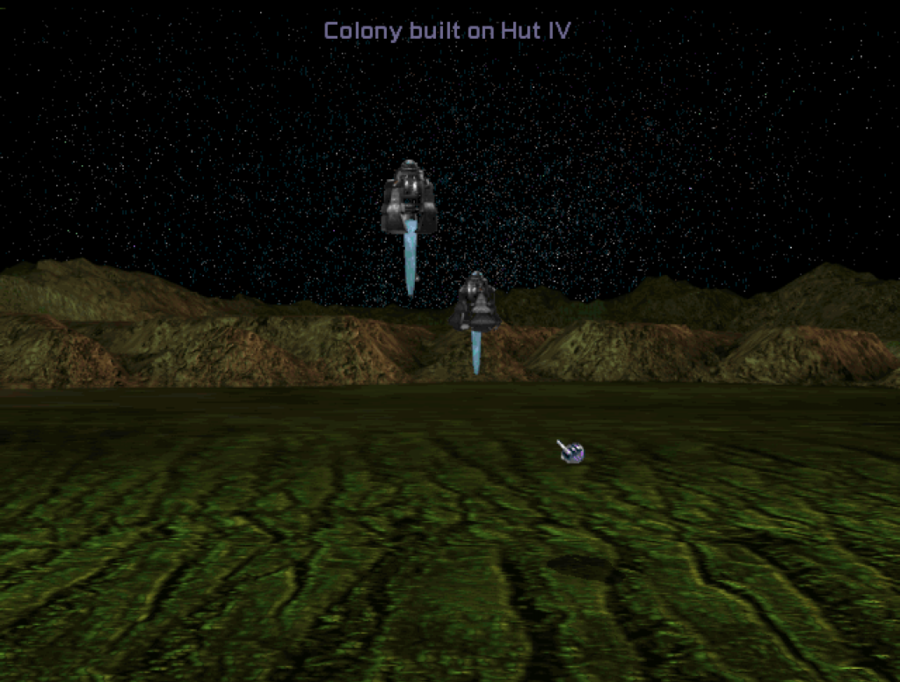
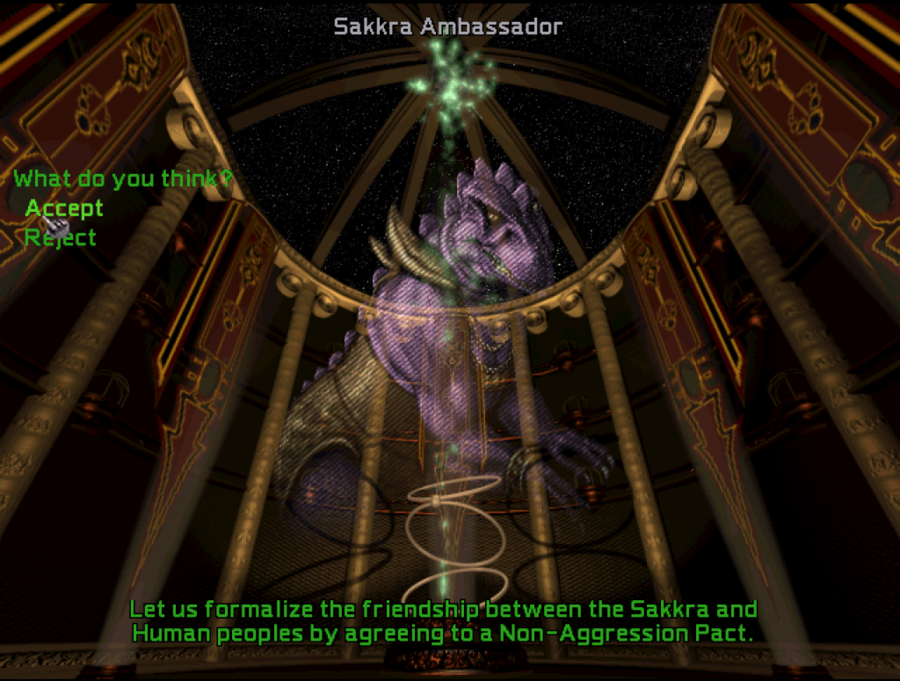
As the United Republic enters the 29th century, popular opinion is torn between optimism about the future and fear of the potential of aggression from the Sakkra Nations. The Conservatives take firm dominance in the Great Senate, helped by concerns about what threat the Sakkra may present. The new colony at Nieuw Vlaanderen is fully established in 2801, as Earth finishes the construction of expanded port and orbital warehousing facilities to bolster the expanded spaceborne trade the Republic now enjoys. Although Nieuw Vlaanderen profits by its key position along the trade route to the Nations, the populace nonetheless is uneasy about the possibility of aggression by the Nations. When the Great Lord Sarezaear formally recognises the United Republic as a sovereign state with a lawful claim to its own territories and peoples a year later, these fears are lessened, but not altogether quelled.

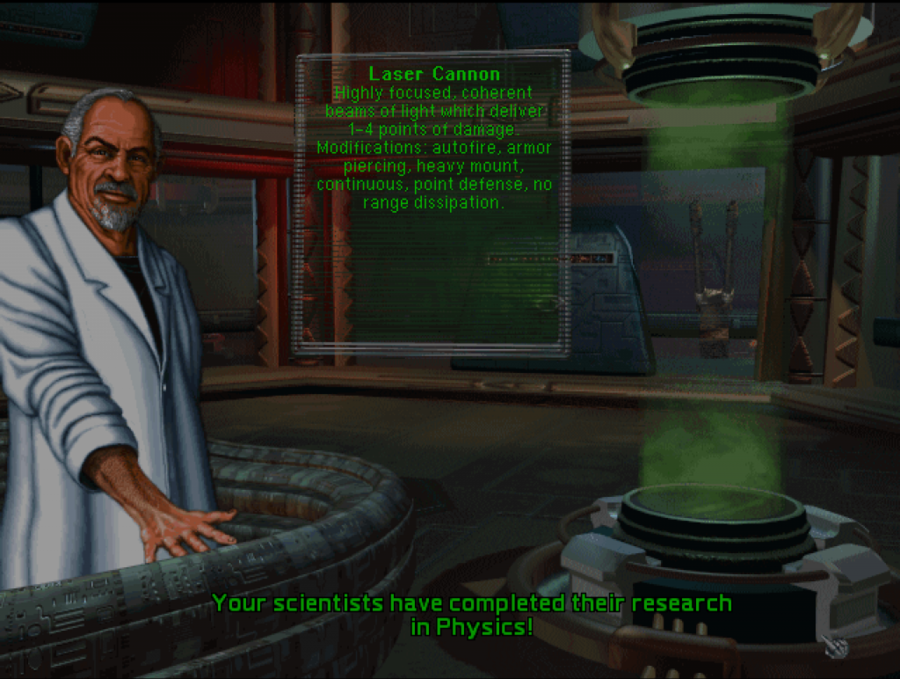
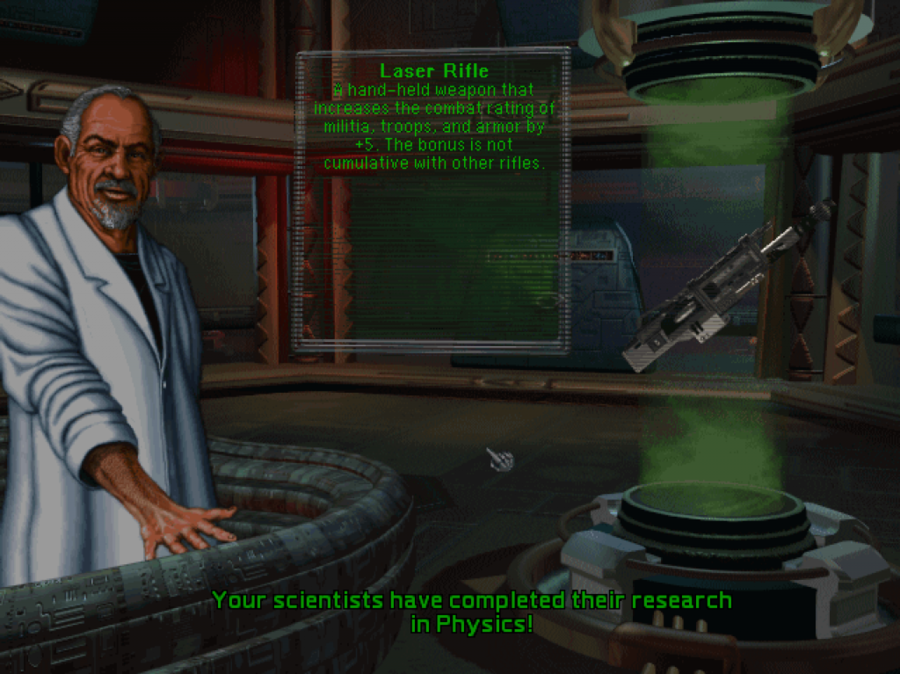
It is in 2805 that Advanced Automation Solutions, Incorporated unveils the new Puppeteer suite of control systems for a line of heavy remote-piloted construction and mining vehicles. Secure and reliable communications links between rugged and versatile work robots and a manned control station allows for intensive mining and construction operations in conditions that would be intolerably hazardous for a Human work crew. Companies and the nascent Republican Star Navy begin investing in the new technology, although the capital investment is steep.
This breakthrough is followed by Zeiss Optics filing patents on high-output solid-state laser technology in 2809, which is rapidly adopted as a replacement weapon for traditional small arms and vehicle cannon by Republican surface forces. Although the firepower of the new laser technology is no better than traditional weaponry, its excellent accuracy provides a distinct jump in performance. Alongside the adoption of laser weaponry, Republican surface forces begin integrating armor based on the new titanium alloys in vehicles, helmets, and trauma plates for the standard Republican Army tactical vest, preparing surface forces for a new generation of warfare.
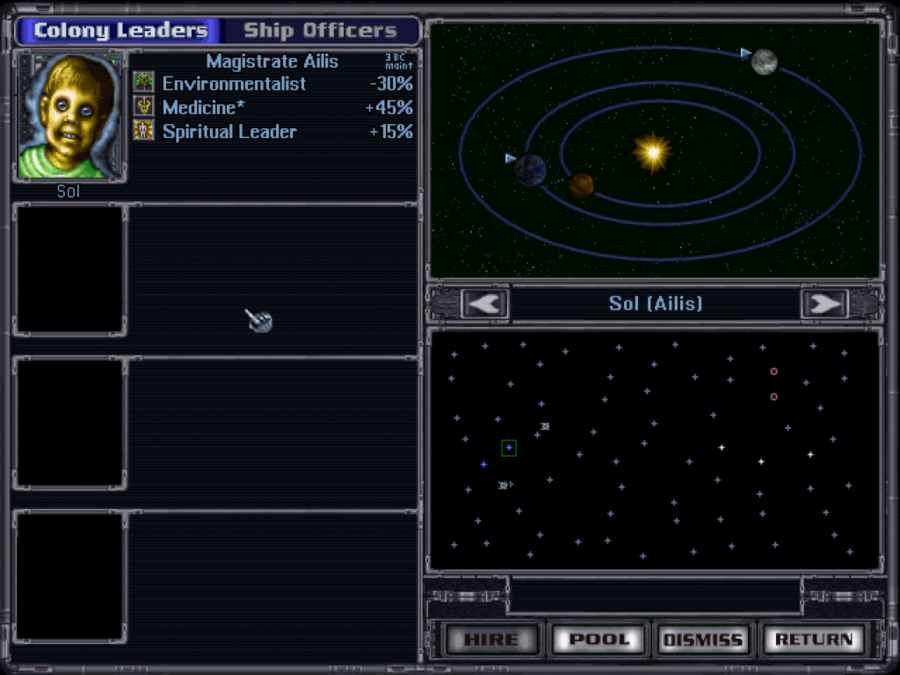
2809 is also the year that NordPharm unveils a series of medical cloning labs for organ replacement and antiagarthic compounds across Earth and Mars. The ease of replacement for failing organs and the drastic reduction in the effects of aging helps keep the people of Earth and Mars healthier, happier, and longer-lived than ever before. Many persons opt to re-enter the workforce as they anticipate a longer life and more vigorous life ahead of them, and the proportion of the population that is retired shrinks over the next several years. Likewise, lost productivity from illness is also reduced. Some investors in NordPharm establish the Green Future Foundation, investing their money in helping to ensure efficient reduction of emissions from the growing heavy industry in-system.
Ailis' Spiritual Leader ability offers a morale bonus to Earth and Mars. Morale provides a percentage bonus to food, industry, science, and cash output of a colony. The Medicine ability helps ensure higher population growth, although with the population filled as it is in Sol this no longer helps. Finally, Environmentalist helps reduce how much industry is wasted by needing to clean up pollution; the Environmentalist gives cheaper and more efficient ways to make sure toxic waste doesn't kill everybody on-site.
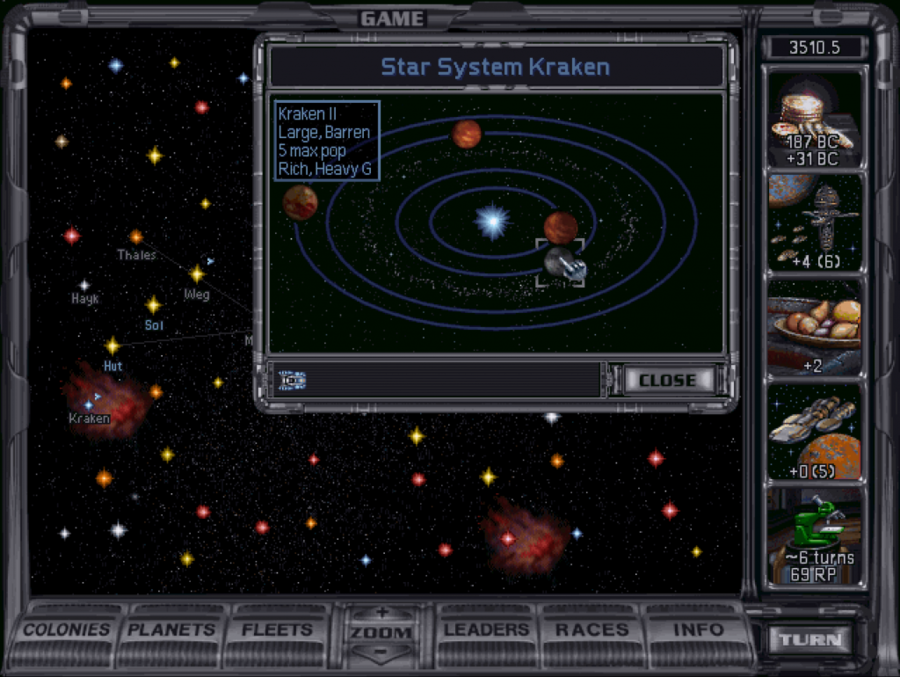
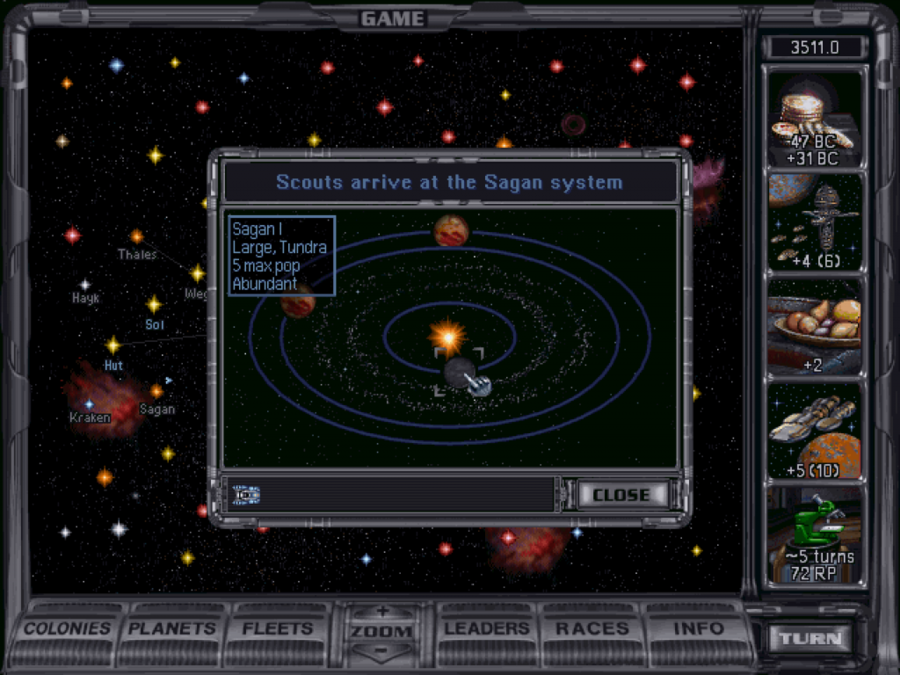
In 2810, the RES Sir Francis Drake dispatches a communications probe from the orange star Sagan, containing details on both Sagan and Kraken, and reporting that its flight through the nebula around Kraken was marked by sudden energy surges through hyperspace that required relatively slow and careful navigation to avoid. Although the planets around Kraken are relatively rich in minerals, all of them have crushing gravity that make them poorly suitable for colonisation, and none have any native biosphere. Laaxaayik, the one planet suitable for colonisation around Sagan, is more promising. Although temperatures hover near the freezing point of water on Laaxaayik, the planet is rich in water and host to a primitive ecosystem of mold, lichen, crustacean, and fish equivalents.
In 2811, Earth finally finishes deploying Puppeteer technology, resulting in a dramatic drop in metals and minerals prices that fuels expanded industrial output. Taking advantage of the new abundance of raw materials, Williamson-Lin Aerospace begins work in earnest on an armaments design and testing process for coilguns, while the infant Republican Star Navy begins to develop a theory of space war based on preliminary studies of Williamson-Lin's data and the experience in space travel of the Republican Exploratory Corps. Investment capital, meanwhile, flows to the new colony on Nieuw Vlaanderen, ensuring that it develops an acceptable industrial base by 2813.

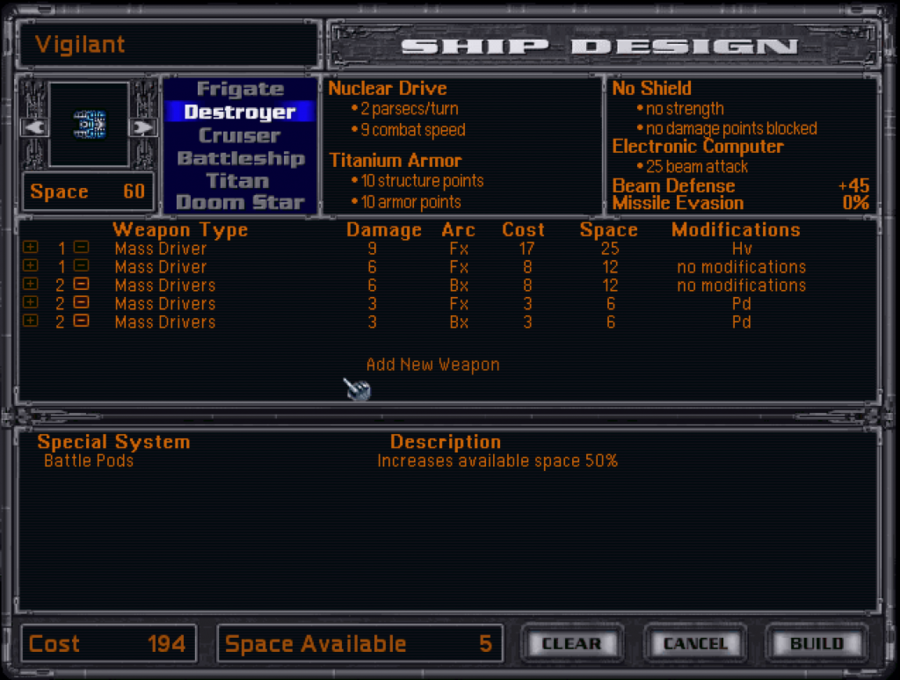
By 2815, Williamson-Lin has finished trials for advanced coilgun weaponry capable of launching dense metallic slugs at very high but non-relativistic speeds. Trials and testing for the heaviest variety of coilgun turret indicate that energy delivered on target by its slugs should slightly exceed that effectively delivered by the nuclear-tipped missiles used by the Leifr Eriksson class, not having the same issue of bleeding off over half its potential energy uselessly off to the rear and sides of a detonation. The Vigilant-class warship is designed and parallel construction on two hulls in orbit around Earth begins. With a heavy primary turret forward, three secondary turrets fore and aft, and four light defensive turrets fore and aft, the Vigilant is designed to work in tandem with a consort, presenting broadsides to the enemy and maintaining overlapping fields of defensive fire to thin out incoming missile volleys.
Our mass drivers are mounted in Forward Extended (Fx) and Back Extended (Bx) arcs, which I interpret as turreted mounts. Forward or back extended arcs can fire to port or starboard quadrants of a ship, as well as fore or aft. Mass drivers can currently accept two modification types: heavy mount or point defense. Heavy mount mass drivers take considerably more space and cannot target missiles or fighters, but deal 150% damage, have a longer maximum range, and suffer reduced penalties to hit from range. Point defense weapons are smaller, deal half damage, and suffer from reduced maximum range and increased range penalties, but enjoy a 25% accuracy bonus, helping them pick off missiles more efficiently at point-blank range. Vigilants presenting their port or starboard to the enemy should be able to bring all guns to bear, and Vigilants lack any dead spots in coverage in the event of dealing with very maneuverable foes.
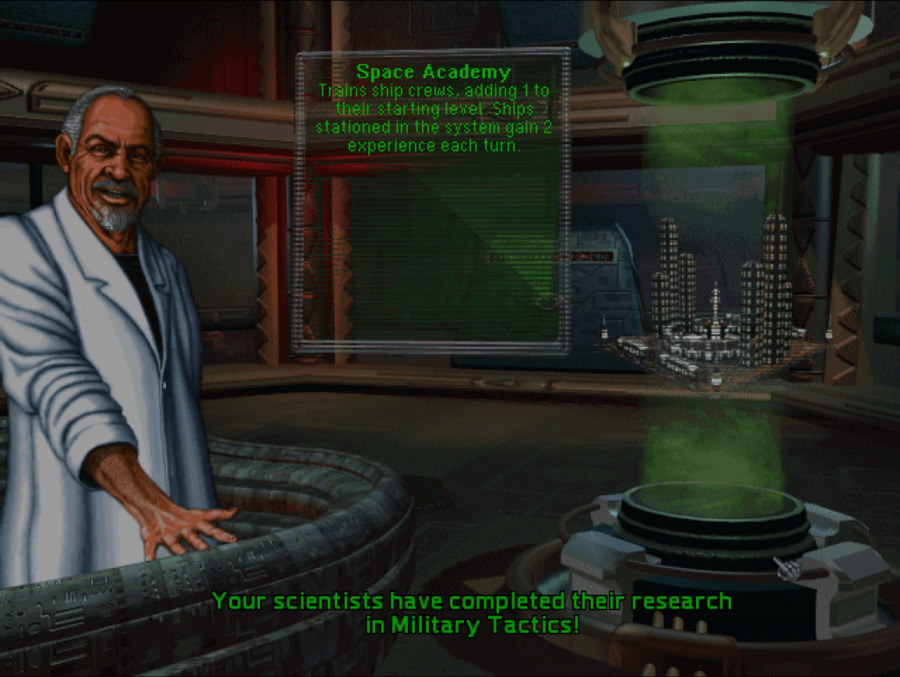
In 2818, naval theorists have elucidated a new doctrine of space war, and the assembled recruits for the RNS Vigilant are drilled intensively over the course of the next two years. It is in 2820 that the RNS Vigilant is commissioned and crewed, leaving behind a new naval academy housed in the orbital shipyards and fortifications around Earth to train the recruits for the planned RNS Alert. The RNS Vigilant now prepares to depart and take up station around Nieuw Vlaanderen, securing the front lines of the Republic.
System Planetary Survey: Hut

The Hut system contains five bodies potentially colonisable by Humanity, although only three show any great promise for settlement. In its inmost orbit is 'the Forge', an Earth-sized world with no atmosphere that suffers from extremes of heat and radiation during its daytime period, and severe cold at night. Survey indicates the Forge contains rich reserves of metals, most notably uranium and tungsten. Mining operations there should be quite valuable, despite the harshness of the environment.
Next out from 'the Forge' is 'the Anvil'. Although larger and slightly cooler than the Forge, the environment of the Anvil is largely similar. It has exploitable mineral reserves comparable to those on Earth or Mars, making it slightly less attractive as a colonisation prospect than the Forge.
Next out is 'Gobi'. Gobi is a Mercury-sized planet with a thin, turbulent atmosphere, average surface temperatures of 55 Celsius, and low gravitation. There is little room for settlement and a lack of any special resources to make it worth the investment of settlement, considering the harsh conditions on the surface.
Nieuw Vlaanderen, the next out, is, of course, the most attractive prospect for colonisation in the Hut system, and is already undergoing settlement and exploitation. The oxygen-nitrogen atmosphere is breathable by unprotected Humans, the climate is similar to that of Earth, there is a huge amount of space for settlement, and Earth crops have proven to be viable in Hut's soil with only minimal adaptation to local conditions.
Finally, the last body before the outer system is 'Fool's Hope'. Although rich in metals and useful volatile chemical compounds, Fool's Hope is not recommended for colonisation. Its atmosphere is a thick, cool solution of fluorine and chlorine compounds that would be violently reactive with the materials of any settlement on the planet. Protective measures could be taken, but Fool's Hope would remain an expensive and dangerous location for any settlement.
The United Republic in 2820
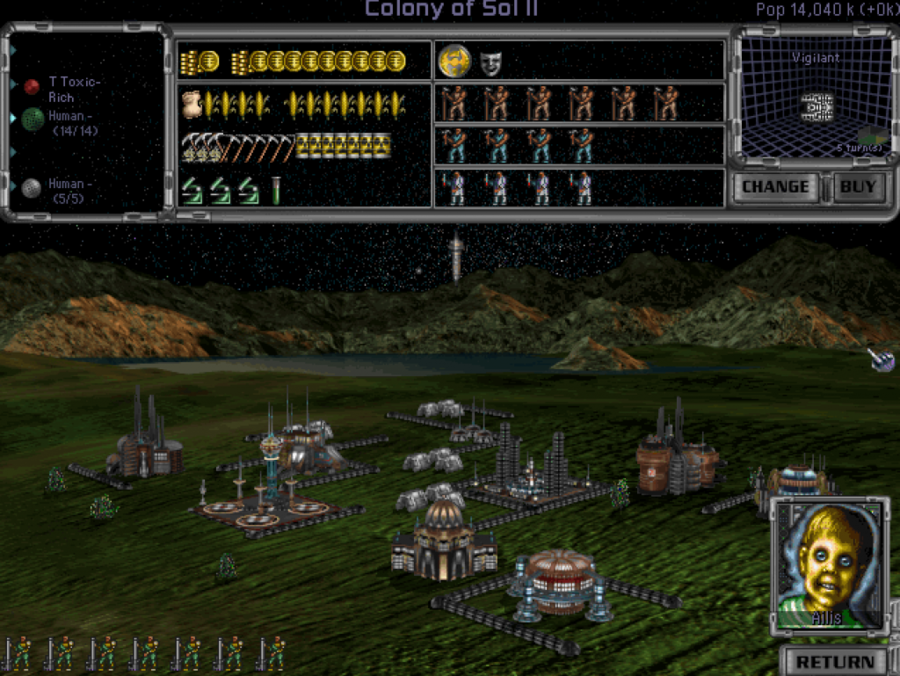
Earth is the commercial as well as the political hub of the Republic, maintaining warehousing and shipping facilities that cement its role as the linchpin of trade. With the drop in raw materials prices that followed the deployment of Puppeteer technology fueling cheaper manufacturing, the expansion of trade with Mars, Nieuw Vlaanderen, and the Nations, and the benefits of NordPharm's innovations, the population of Earth is richer, healthier, and happier than ever before. The Republican Naval Academy in orbit serves as a nexus for the training of recruits for service in the new Republican Star Navy, and the keel has been laid for the RNS Alert, the sister ship of the RNS Vigilant. The intense heavy industry supporting this naval construction necessitates annual flights carrying toxic waste to Mercury as a planetary waste dump. This ensures the continued health and environmental quality of Earth for its inhabitants.
The smiling theater mask indicates a positive morale bonus of between 10 and 20 percent. One such mask appears for each 10% of morale bonus. The stylised eagle symbol by it indicates that we enjoy a Democratic government.
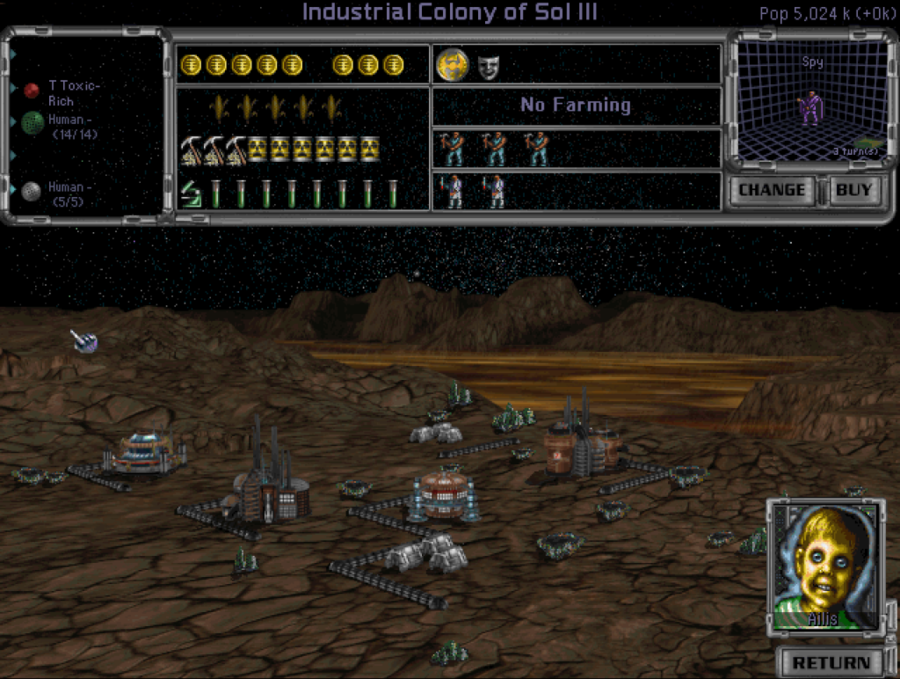
Mars has likewise prospered over the past twenty years from the effects of Puppeteer and the NordPharm services, although local facilities have difficulty servicing demand for commercial shipping to Mars. Heavy industry's investment in any commercial port and warehousing facilities has largely lagged in favor of supply contracts to the expanding RCSPS. The local population has stabilised at just over five billion persons, with no real population growth anticipated in the future. Waste disposal is also a significant expense on Mars, now, partly offsetting the gains in prosperity from the new technology.
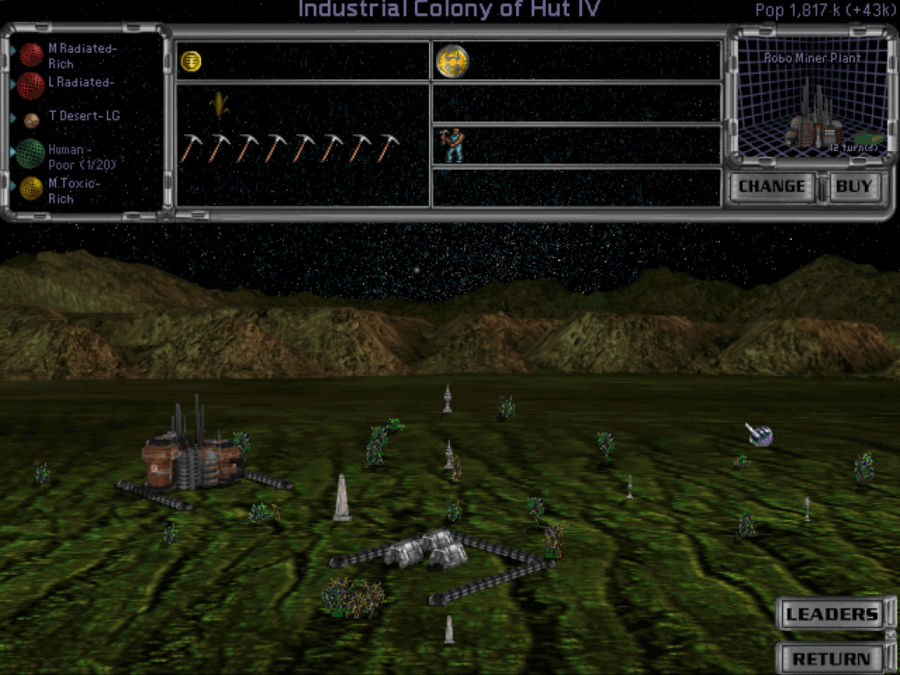
Conditions on Nieuw Vlaanderen remain far more primitive, although the colony has taken great strides in the twenty years it has been fully established. Its population has nearly doubled, with the locals raising large families in response to the incredible abundance of habitable land free for the taking. New factories have emerged in the cities, providing prosperity to the inhabitants of Nieuw Vlaanderen, and imports from both the Nations and from the home system circulate in the cities and markets of Nieuw Vlaanderen. Mines and construction sites have begun deploying Puppeteer technology, although it is far from as universally-used as it is on Earth and Mars.
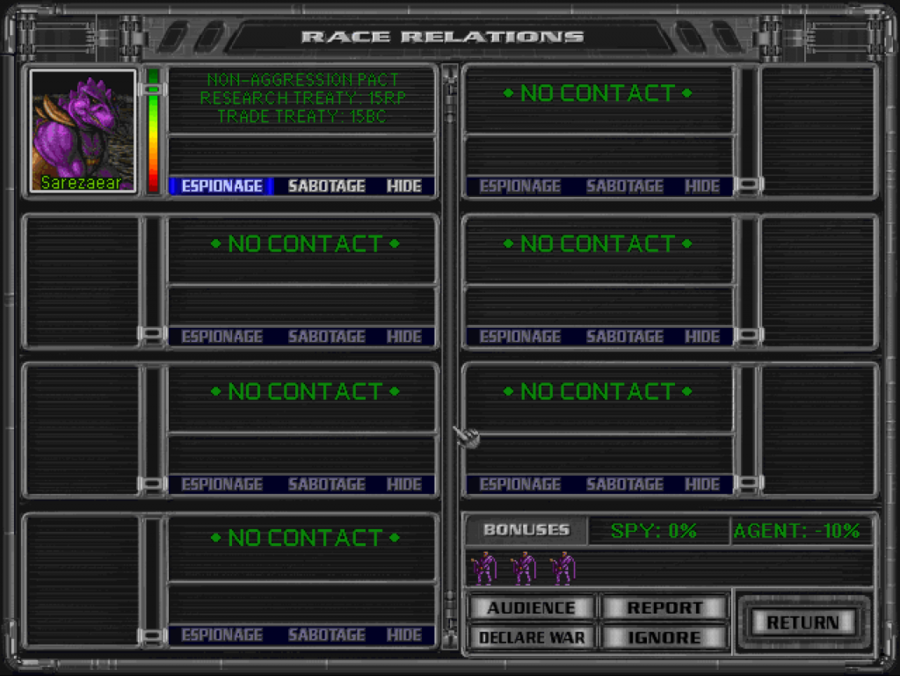
Relations with the Nations remain warm after both governments have recognised each others' legitimacy, and the volume of trade has expanded slightly over time. The RCSPS now stands at 30,000 persons, with more being trained each day.
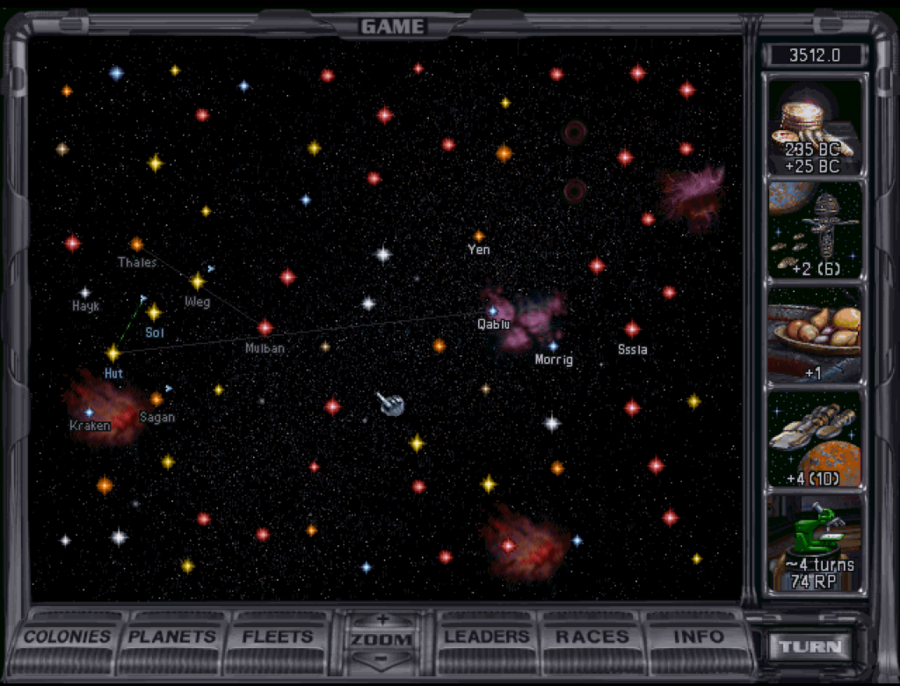
Much of the increased wealth of the United Republic has been plowed back into expanded heavy industry to support the creation of the Republican Star Navy, although there has been a slight growth in the rate at which investment capital is accumulated in the Republic. Commercial shipping has expanded to meet demand, relieving the earlier pressure on transport capacity. Naval analysts predict that once the RNS Alert is commissioned, the Navy will not be able to expand logistics for any new ships beyond that without either new orbital facilities or a severe impact on the civilian economy.
The question remains as to how the Republic will face the future.
All three parties propose to permit the completion of Puppeteer deployment on Nieuw Vlaanderen, before any further developments on the planet.
The Conservatives intend to complete the RNS Alert, thereby filling the original design objective of the Vigilant class operating as a pair, thereafter supporting a new colonial mission to New Greenland. They will further expand the RCSPS to 50,000 persons as a security measure in the event of espionage by the Nations, thereafter relieving the pressure on the civilian economy of Mars for a time before starting construction on a new naval base over Mars. Once Puppeteer technology is deployed on Nieuw Vlaanderen, they intend to start construction on a naval base over the planet to support the Vigilant and Alert. They wish to support new materials science, development of viable railgun weaponry for surface forces to supplant lasers, and various other research projects with potential military applications, potentially allowing refinements in the design of Naval vessels.
The Social Democrats want to institute population bounties on Nieuw Vlaanderen and emigration incentives for new families from Earth or Mars to move there. After the population of Nieuw Vlaanderen grows somewhat larger, they intend to use it as a base from which settlers from Earth and Mars can be incentivised to establish a new colony on the Forge, with less expense than needed for a true colony fleet to an uninhabited system. Meanwhile, they wish to continue recruiting and equipping for the RCSPS on Mars until it reaches 100,000 and delay the construction of the Alert until after the dispatch of a new colonial mission to New Greenland. They wish to support research marked for use by the RCSPS and medical foundations, before pushing for new power storage technologies for ships, in the hope the advances in chemistry may be able to support breakthroughs to improve environmental quality on Earth and Mars.
The Liberals wish to reduce industrial subsidies, relying on market demand to drive a new colonial mission to New Greenland before finishing the Alert on a tighter budget than that proposed by the Conservatives. They believe the current staffing of the RCSPS should be sufficient for the moment. Market analysts expect civilian investment to meet Mars' demand to more easily handle shipping and trade capacity, and to support the development of agricultural and tech sector investment on Nieuw Vlaanderen. As always, R&D departments are expected to expand with reduced industrial subsidies. It is expected that commercial demand to improve marketing and communications with Sakkra may lead to breakthroughs in xenology. Market demand is also strong for medical technology, new shipbuilding materials, and low-cost solutions to waste disposal problems.